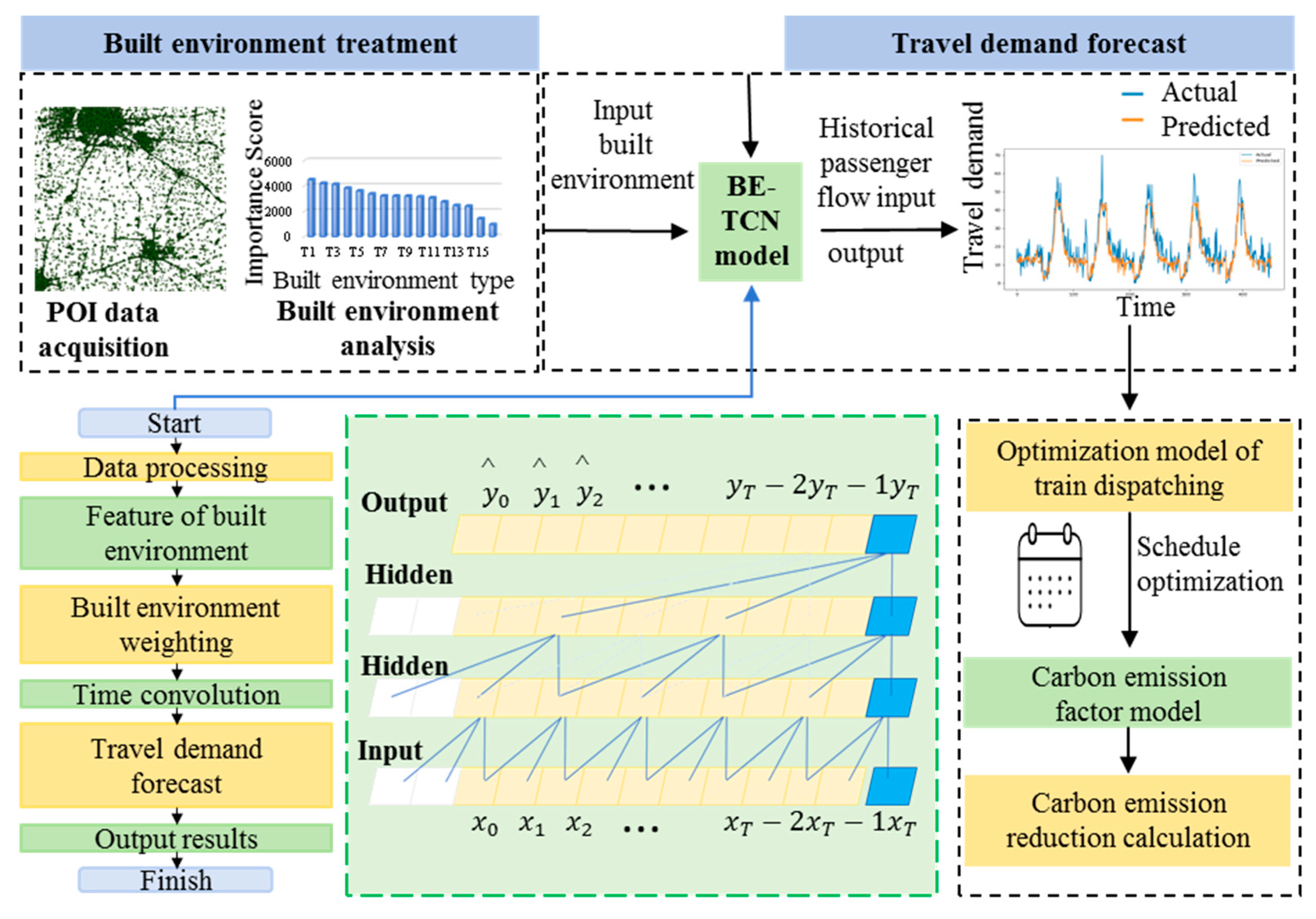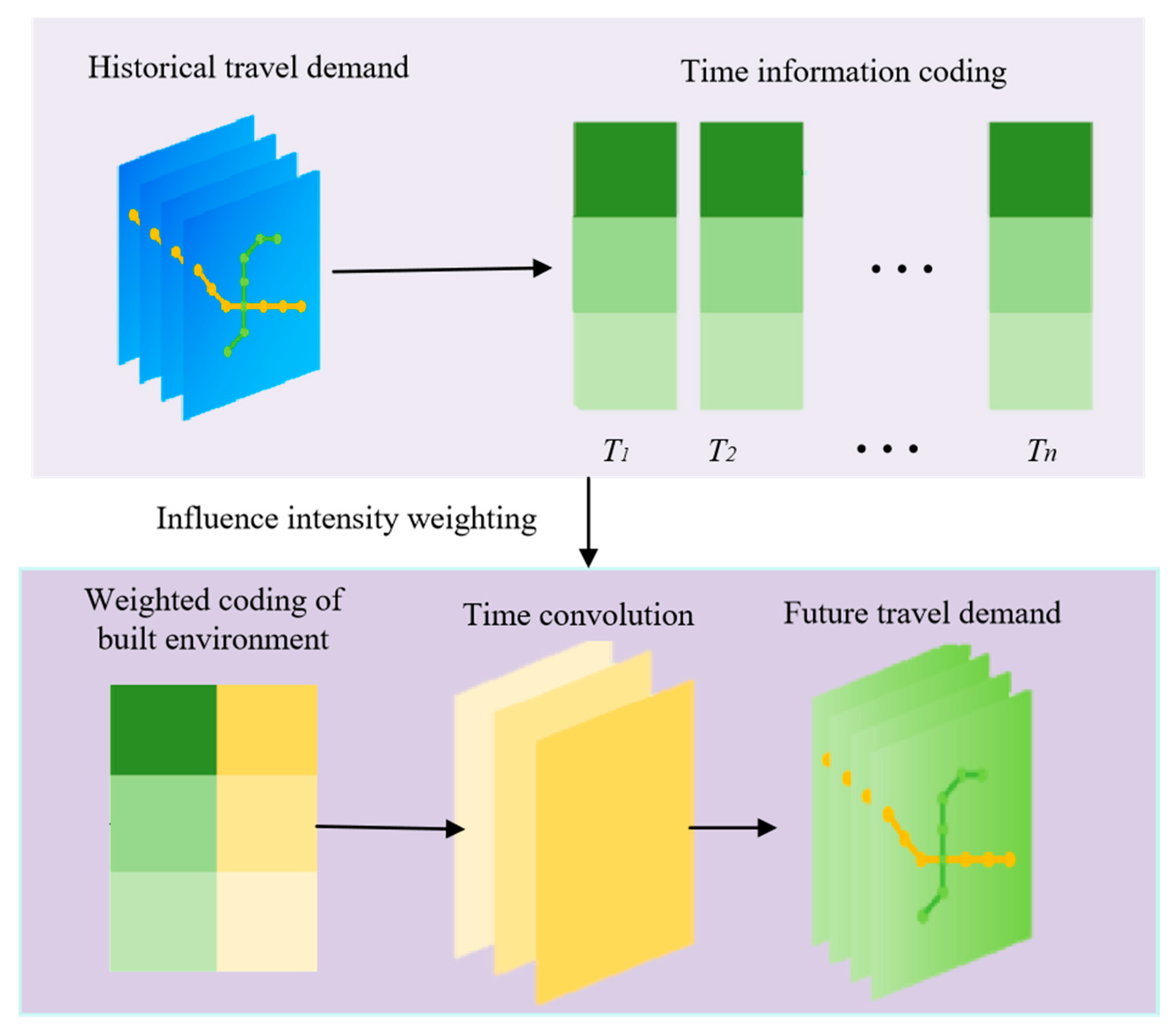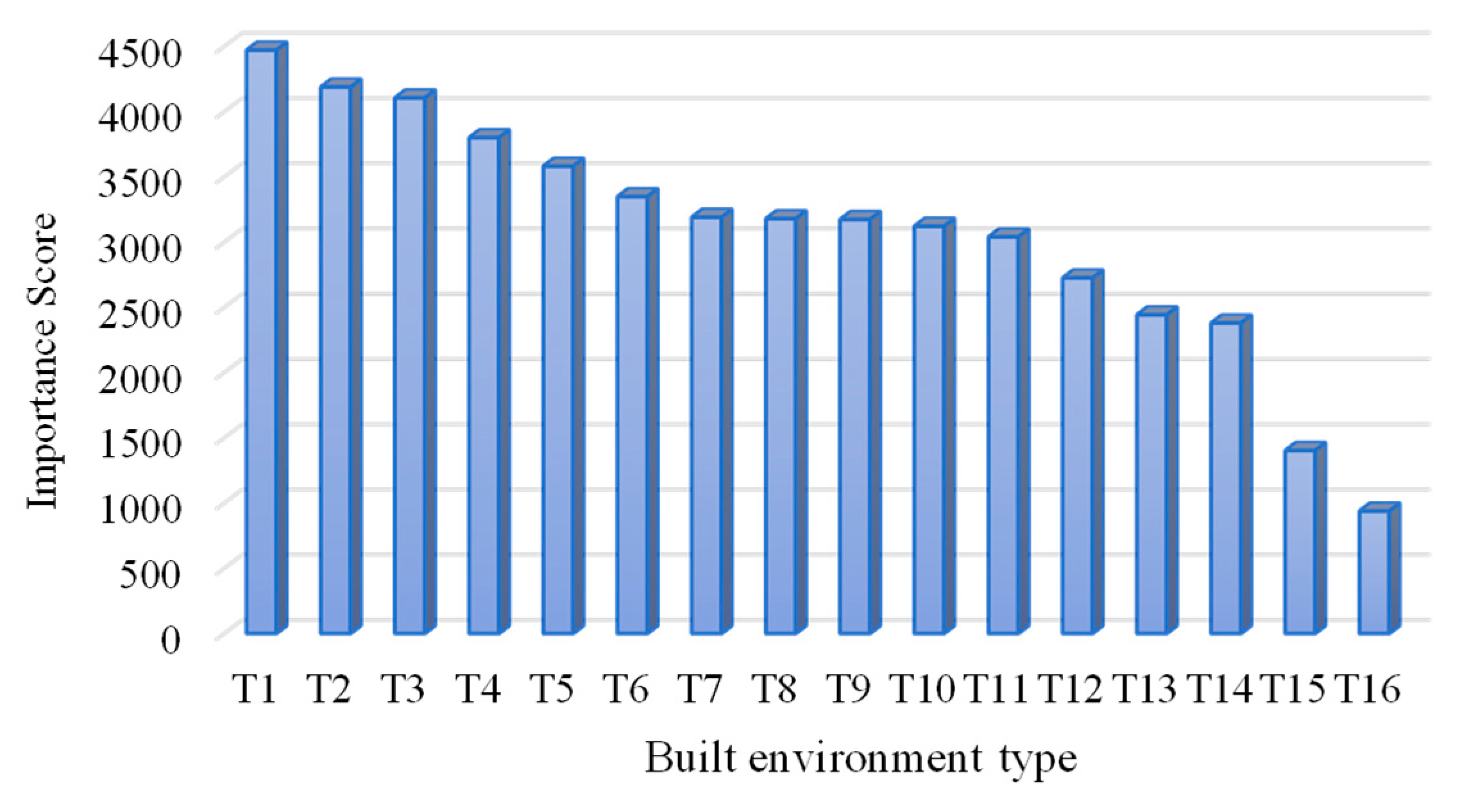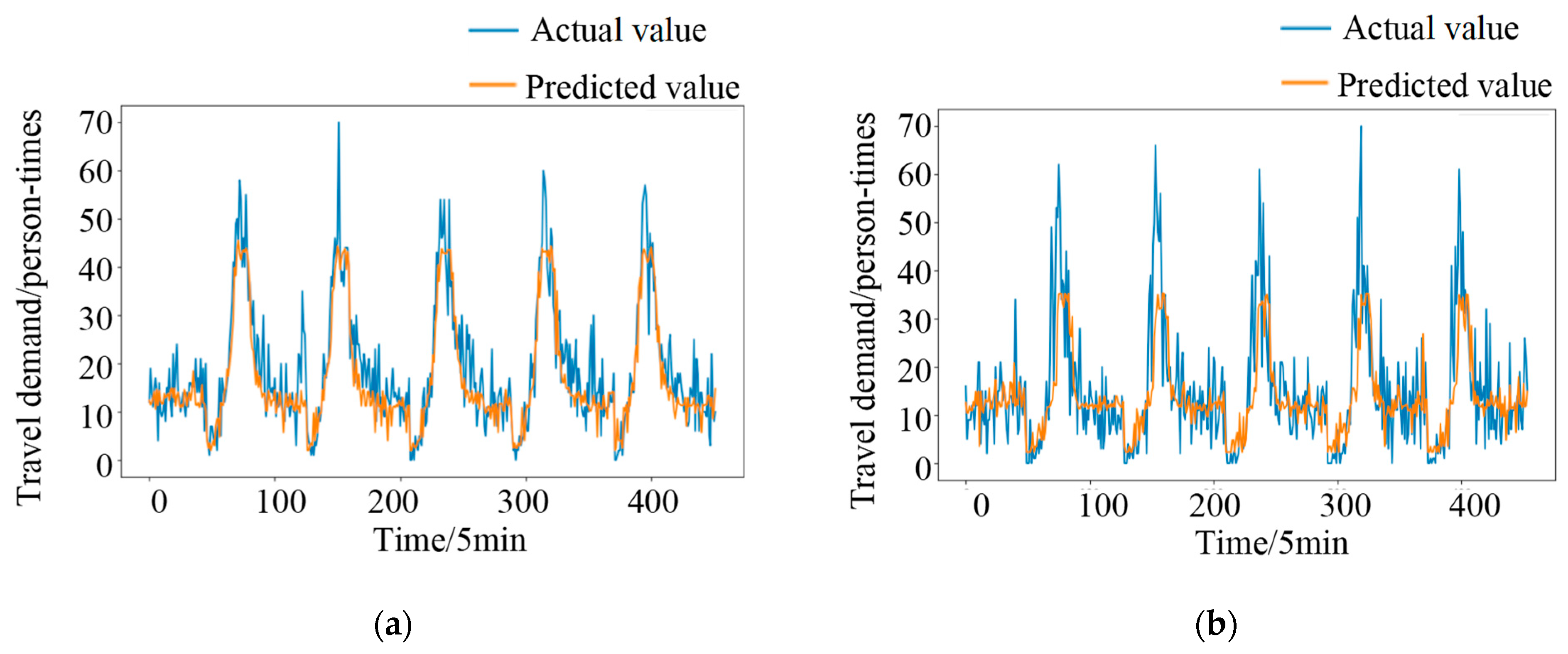1. Introduction
As a crucial mode of low-carbon transportation, urban rail transit faces a prominent issue of supply–demand imbalance during off-peak hours [
1,
2]. Existing research indicates that the average load factor during off-peak periods in major cities in China is less than 30%, yet the trains continue to operate on fixed schedules, resulting in 20–30% of their mileage being wasted on ineffective runs and significant energy inefficiency. The carbon emission intensity per passenger-kilometer during off-peak periods is 40–60% higher than during peak hours [
3,
4], which leads to an annual carbon redundancy exceeding 6 million tons of CO₂. Traditional static scheduling models struggle to adapt to the characteristics of the built environment and dynamic travel demand fluctuations [
5], such as tidal passenger flows and holiday travel patterns. Therefore, developing intelligent scheduling methods based on dynamic demand prediction is conducive to improving the energy efficiency of rail transit and assisting in the achievement of the “dual carbon” goals. Currently, the research on the low-carbon operation and planning of urban rail transit is increasingly focusing on the coupling relationship between the built environment and transportation systems. However, existing modeling methods still exhibit significant limitations in characterizing the heterogeneous impacts between rail stations. Most studies, by employing static POI-weighted or historical average prediction methods, fail to fully account for the dynamic differences among stations in terms of their passenger flow, land use, energy consumption, and carbon emission characteristics, which results in limited model accuracy and applicability. Jia et al. [
6] and Chen et al. [
7] quantified the environmental benefits of rail transit from the perspectives of carbon reduction and energy consumption prediction, respectively, but relied on static POI-weighted or historical average methods [
8], which inadequately capture the dynamic influence of functional differences among stations on their passenger flow and energy consumption. Studies that utilized causal inference and spatial network analysis have uncovered the relationship between the built environment and passenger flow [
9,
10], but these models operate under the assumption of homogeneous effects across stations while overlooking the differentiated interaction effects that stem from varying locations. Some scholars have attempted to introduce dynamic analytical frameworks to improve heterogeneity modeling. Lei et al. [
11] and Wen et al. [
12] optimized traffic demand prediction from the perspectives of spatiotemporal context and dynamic demand, respectively, but did not systematically integrate the multidimensional dynamic characteristics of the built environment. Research on energy efficiency [
13] has refined the analysis of energy consumption differences between different train tractions and station operations, yet the modulating effects of environmental heterogeneity at the station level [
14,
15] on energy consumption remain insufficiently modeled. Future research needs to further integrate dynamic data and heterogeneity modeling methods to more accurately reflect the impact of inter-station differences on the environmental performance of rail transit. Niu et al.’s [
16] collaborative energy-saving optimization model could be extended to scenarios with heterogeneous built environments, while Yuan et al.’s [
17] proposed life-cycle carbon emission measurement framework requires refinement by incorporating station-level characteristic differences.
In recent years, the research in the field of public transportation system planning and management has been continuously deepening. Traditional static transit assignment models, which assume fixed bus stops, struggle to adapt to the dynamic changes encountered in actual operations [
18]. In contrast, dynamic bus stop simulations can integrate the real-time passenger demand and traffic conditions [
19]. By employing methods such as dynamic spatiotemporal multiscale representation, these simulations can more accurately predict passenger flows, optimize stop locations and operations, and adapt to the complexity and uncertainty of urban transportation [
20]. In the realm of multi-objective transit network design, this problem is often framed as a set covering problem, which necessitates the simultaneous optimization of multiple objectives, including route coverage, operational costs, and service quality. Ahern et al. [
21] proposed an approximate multi-objective optimization approach that integrates route design with service frequency settings. This approach also incorporates intelligent algorithms such as genetic algorithms and particle swarm optimization to enhance the solution’s efficiency and optimization effectiveness, and thereby offers new insights into transit network design. In the context of transit user assignment problems, the interval network representation method has gained prominence due to its ability to better reflect network uncertainty and complexity. For instance, Du et al. [
22] introduced a Weibit sequence transit assignment model based on hyperpath graphs and generalized extreme value network representations. This model accounts for passengers’ travel choice behaviors and network dynamic characteristics. The applicability of this representation method in scenarios such as congested and multimodal transportation networks has also been explored, which has provided new perspectives and solutions for transit user assignment. These studies have advanced the scientific and refined planning and management of public transportation systems, offering new theories and methods for optimizing transit systems and providing valuable references for practical applications. With ongoing technological advancement and data accumulation, more breakthroughs are anticipated in the future.
In the field of low-carbon transportation scheduling and decision-making, optimization problems under multi-constraint coupling have attracted increasing attention. Traditional optimization models often focus on a single objective (e.g., energy consumption minimization), but actual operations require the coordinated optimization of multiple constraints, such as passenger waiting time thresholds, the travel demand, and grid carbon emission factors, which leads to significant conflicts among objectives. To address this issue, existing research has explored multi-objective optimization methods, scheduling strategies, and low-carbon constraint modeling. Some scholars have adopted multi-objective linear programming approaches. Li et al. [
23] and Yuan et al. [
24] optimized operational strategies from the perspectives of energy efficiency and service quality, and real-time scheduling and passenger flow control, respectively. Nakano et al. [
25] proposed a low-carbon charging strategy for electric buses, emphasizing dynamic adjustments based on real-time conditions. Multi-objective linear programming has been used to optimize transportation structures and land use [
26,
27], but static modeling methods struggle to adapt to dynamic passenger flow fluctuations and energy supply–demand variations during peak hours. Efforts have also been made to introduce multi-objective optimization methods to balance conflicts among different constraints. Multi-objective optimization frameworks have been employed to coordinate public transport mode selection and carbon reduction goals [
28,
29], yet these approaches still rely on offline optimization and lack real-time dynamic adjustment capabilities. Evolutionary algorithms such as NSGA-II [
30,
31] can handle high-dimensional objective spaces, but their computational efficiency and adaptability to complex dynamic environments remain insufficient. Ning et al. [
32] proposed a multi-agent reinforcement learning (MARL)-based train scheduling method to dynamically optimize the energy consumption and operational efficiency of train scheduling, but the impact of grid low-carbon scheduling (e.g., time-of-use pricing and renewable energy integration) on operational decisions has not been thoroughly analyzed. Although Wang et al.’s [
33] data mining model can predict residents’ low-carbon travel patterns, this model has not been integrated into a closed-loop feedback system with real-time scheduling.
There are some limitations in the existing research. Traditional optimization models and certain multi-objective linear programming methods exhibit static characteristics, making it difficult for them to effectively adapt to the dynamic changes in passenger flow and energy supply-demand during peak hours. Although multi-objective optimization frameworks have been explored, most of them still rely on offline optimization and lack real-time dynamic adjustment capabilities, particularly under complex dynamic conditions such as sudden passenger surges and grid-load fluctuations.
A scheduling framework with multi-objective constraints is proposed in this study. First, to address the interaction between urban residents’ travel demand and the built environment, a Built Environment-Time Convolutional Network (BE-TCN) is constructed, which dynamically incorporates built environment factors by assigning weights to them based on their differential influence on the travel demand, while also incorporating historical travel data, to achieve the precise prediction of future travel demand. Second, an optimization model for urban rail transit daily operation scheduling is developed based on the predicted travel demand; further, it fully considers constraints such as the passenger waiting time and train capacity, aiming to minimize the number of train dispatches and achieve an optimal carbon reduction solution. Finally, the proposed methods are validated using a dataset from Hangzhou urban rail transit. The research methodology is illustrated in
Figure 1. This paper contributes meaningfully to the field of multi-objective scheduling by introducing an integrated framework. This framework aims to enhance the accuracy of passenger flow forecasting through the application of the BE-TCN model, which effectively captures spatiotemporal patterns. It also strives to achieve a more balanced optimization of operational efficiency, carbon footprint reduction, and passenger satisfaction within real-time scheduling. Additionally, this paper offers an in-depth analysis of the interrelationship between the built environment and passenger flow, proposing practical strategies that could potentially support sustainable transportation planning. The findings of this study provide scientific decision-making support for urban rail transit managers in the formulation of differentiated train operation plans that align with travel demand, and thereby contributes to the promotion of carbon emission reduction in urban rail transit systems.
2. Methods
2.1. Data Sources and Processing
In this study, built environment PIO data of Hangzhou’s rail transit stations were collected, as well as the passenger flow data from entrance/exit gate counters on the operational routes of 74 stations for the period from 1 January 2019 to 25 January 2019. These datasets underwent rigorous cleaning and classification, including temporal segmentation (by time periods) and entry/exit differentiation, followed by data preprocessing steps such as standardization and normalization. The station attraction areas were determined based on a combination of factors including commercial facilities, public service facilities, green spaces and squares, work offices, business residences, and residential land use. The built environment data of Hangzhou’s urban rail transit stations are shown in
Table 1. Due to the large number of stations (74 in total), for each of which the data include entry/exit IDs and the number of passengers entering during different time periods (5 min intervals), only the passenger entry numbers for stations 0–10 during the 7:00–8:00 time period are shown in
Table 2.
2.2. Construction of XGBoost Model Based on the Impact of Built Environment on Residents’ Travel Demand
XGBoost is an efficient gradient-lifting decision tree model that is widely used in the field of large-scale data analysis. This model has enhanced prediction accuracy due to optimizing the loss function and capturing complex nonlinear relationships. This model incorporates a built-in feature importance scoring function that allows for the intuitive evaluation of variable impacts on specific objectives. By leveraging L1 and L2 regularization techniques, the model effectively manages the process’s complexity and curtails the risk of overfitting, which thereby enhances its robustness. Additionally, the model boasts strong visualization capabilities, which facilitate easy interpretation of the results. This model helps to capture the complex relationship between the built environment and travel demand and accurately identify the key influencing factors. Therefore, this paper discusses the impact of the built environment on residents’ travel demand based on the XGBoost model.
The model construction steps are as follows: First, the built environment data are divided into a training set and a testing set in a ratio of 70/30%. Secondly, the model is optimized by adjusting the regularization parameter, sampling strategy, and learning rate to enhance its performance and prevent overfitting. The training process is configured to run for 5000 iterations. Finally, the number of times that each built environment-related feature is used to split nodes across all decision trees is added up, and the weights of each feature in all decision trees are considered comprehensively to evaluate the importance of the built environment features. The parameters of the XGBoost model are presented in
Table 3.
The calculation method of the importance score of the XGBoost model is shown in Equation (1):
where
is the importance score;
represents the total number of trees;
is the number of times that feature i is used to split nodes in the
jth tree.
2.3. BE-TCN Model Construction of Urban Residents’ Travel Demand Prediction Based on Built Environment Weighting
To investigate the differential impacts of the built environment on urban rail transit travel demand, the BE-TCN model, a weighted prediction framework that accounts for the varying intensity of the influence of the built environment, is proposed. The model incorporates a weighting mechanism that uses the intensity of built environment influences as weights to accurately depict the patterns of demand variation. By leveraging the advantages of temporal convolutional networks, the BE-TCN model effectively captures long-term dependencies in time-series data, achieving a significantly enhanced prediction accuracy and robustness. Additionally, this model supports the fusion of multi-dimensional features, including built environment indicators, historical travel data, and temporal information, to comprehensively represent complex travel scenarios and provide reliable technical support for urban rail transit demand prediction.
The BE-TCN model, a temporal convolutional network architecture, is designed for the forecasting of future travel demand. Initially, historical travel demand data are encoded into a sequential temporal information format. Subsequently, weighted encoding mechanisms are applied to incorporate the influence of the built environment. The encoded data are then processed through temporal convolutional layers to extract features at various time scales, facilitating the generation of future travel demand predictions. The diagrammatic representation below outlines the key stages of the process: historical travel demand data are transformed into temporal information; weighted encoding of the built environment enhances the model’s consideration of environmental factors; and temporal convolution operations on these encodings enable future travel demand prediction. The framework of the BE-TCN model is illustrated in
Figure 2.
2.3.1. TCN Model
is the objective function at time
t, and is calculated by Equation (2):
where
is the input data at time t;
is the model parameter.
2.3.2. Built Environment Weighting
In the built environment weighting,
is the sum of the weighted feature predictions, as show in Equation (3):
where
is the weight related to the ith variable
is the predicted output of the ith variable.
2.3.3. Predictive Output
is the predictive output
is the activation function, as shown in Equation (4):
2.3.4. Error Indicators
Mean absolute error (MAE) and root mean squared error (RMSE) were used to evaluate the prediction results of the model, as shown in Equations (5) and (6), where
is the actual value;
is the predicted value; n is the number of samples.
2.4. Construction of an Optimization Model for Urban Rail Transit Train Scheduling Considering Carbon Emission Reduction
To achieve the carbon emission reduction targets and enhance the operational efficiency of urban rail transit systems, this paper constructs an optimization model for urban rail transit train scheduling that considers carbon emission reduction objectives. Firstly, an objective function is devised with the overarching goals of minimizing train service frequency, passenger waiting times, and carbon emissions. Corresponding weights are allocated to these distinct objectives to reflect their relative importance. Secondly, optimization constraints are established, including the passenger waiting time, operational time intervals, and suitable train passenger capacities, to ensure the feasibility of the train scheduling plan. Finally, a linear programming model is employed to solve the optimization model. This approach aims to achieve more efficient and environmentally friendly urban rail transit operations.
2.4.1. Objective Function
In this study, the mixed-integer linear programming (MILP) methodology was adopted to address the optimization model, in which Pyomo, an open-source modeling framework implemented in Python 3.9.13, was also integrated. Regarding the solver selection, CBC, a widely recognized open-source solver for linear and mixed-integer linear programming problems, was employed.
With respect to the determination of weight settings, extensive reference was made to the pertinent literature within the field, and consultations were conducted with domain experts. Zhu, C. et al. [
34] and Yu, D. et al. [
35] presented valuable reference methodologies for choosing weight settings in analogous problems. Furthermore, given the practical application context, in-depth discussions were undertaken with experts to achieve a balanced consideration of the impacts of the number of departures, the volume of waiting passengers, and carbon emissions within the objective function, which allowed us to delineate a reasonable range for the weights.
To evaluate the computational efficiency of the solution approach, the computation time for each experimental run was meticulously recorded. Ultimately, the resultant scheduling timetable was preserved for subsequent analytical procedures and practical applications.
The preparation of the urban rail transit train operation plan included three optimization objectives: minimum departure times, passenger waiting time, and carbon emissions. The objective function
is calculated using Equation (7):
where the system decision variable
indicates whether the line
sends out the train at time
;
is the waiting time
at station
;
is the collection of Hangzhou urban rail transit train lines;
is the time period for preparing the operation plan;
is the set of stations
on the line;
refers to the carbon emissions consumed by the train running once on line
l.
2.4.2. Constraint Condition
- 2.
Passenger waiting time constraints: passenger flow entering station S at time of ; indicates whether the train sent at time arrives at station at time ; is the arrival time.
- 3.
Operation time interval constraints: is the minimum departure interval.
- 4.
Suitable passenger capacity of train: passenger flow boarding the line at time ; is the maximum passenger capacity of the train, and in this study, . To ensure passenger comfort, the appropriate passenger capacity of the train is 80% of the maximum passenger capacity.
2.5. Construction of Carbon Emission Factor Model of Urban Rail Transit
Carbon emissions are generated by traction electricity consumption during the operation of urban rail transit systems [
36]. A top-down approach is employed to calculate carbon emissions by analyzing the electricity consumption data and power emission factors of the urban rail transit system. The carbon emission factor model integrates the passenger flow demand forecast, operation characteristics, vehicle energy consumption, and carbon emission conversion coefficient of grid power generation to provide accurate carbon emission estimation. When calculating the indirect emissions from purchasing electricity, public institutions usually use the average emission factor of the national grid as a reference. This study selects the value (0.6101 tCO
2/mwh) provided by the national development and reform commission in their guidelines for accounting methods and reporting related to greenhouse gas emissions for enterprises from 2013 to 2015 to calculate the indirect emissions corresponding to the purchase of electricity [
37].
Carbon emissions due to traction power consumption during urban rail transit operation:
represents the total carbon emissions during the operation phase of urban rail transit trains, as shown in Equation (15):
where
represents the traction energy consumption of urban rail transit trains, in kW·h;
represents the electricity emission factor (average level of the national power grid), in kg
/kW·h.
The input data for the model include the following: an inbound passenger flow matrix, recorded at 5 min intervals and expanded to 1 min intervals; an outbound passenger flow matrix, also recorded at 5 min intervals and expanded to 1 min intervals; and an inter-station time matrix, which contains the station numbers and their corresponding running times for each line. Additionally, the station number ranges for three lines—Line 1, Line 2, and Line 4—are defined, and the maximum passenger capacity of the trains is set at 1450 people. The weighting parameters α, β, and γ are set to 40%, 40%, and 20%, respectively, to balance the impacts of the number of departures, the number of waiting passengers, and carbon emissions in the objective function.















